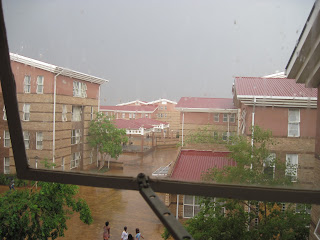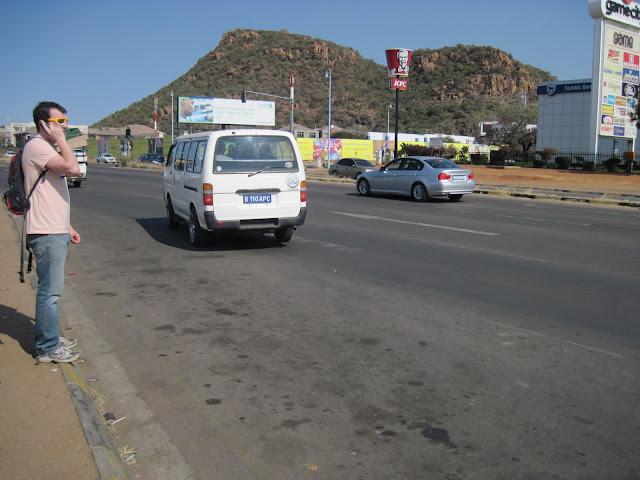So, this past weekend I went to a village called Mochudi about an hour away from Gaborone for my friend Grinni's aunt's wedding with a couple friends, Fidelia and Martha. We left on Friday evening from the university, but were running very late because we had been waiting for two of Grinni's friends for over an hour. Frustrated, we eventually gave up and left without them. There is a phenomenon here that people call "Africa Time," which is essentially the same concept as "Island Time," where people tend to take their time doing things and will often show up late to gatherings. I think that these girls were even later than the socially accepted and expected lateness because my friend was certainly livid. She was worried the whole time that her mother was going to yell at her when we finally did arrive.
The form of transport to the wedding was a very old truck owned by the Rotatract Club, endearingly called "The Anti-Christ." This endearment undoubtedly comes from the comfortable and secure feelings it inspires in its passengers, especially those occupants riding in the bed of the truck. Further evidence of its evil intentions is that it ripped my favorite dress when I was sitting in the back. Grinni assures me that it can be fixed, I just have to think more like an African.
 |
| This picture does not really capture the full character of the truck, but I am sure you can appreciate "The Anti-Christ," from my description. |
When we arrived at the house around 8, it was after a long, cold ride in "The Anti-Christ." I was glad to finally stop moving and feel warm again--the coldest thing was the sharp breeze that just goes right through your clothes like needles. Grinni had warned us that she had a very large family. Her grandmother had fourteen children, then of course these children all had at least three or four (usually more) children of their own. This meant that there might be about 120 people at the house when we arrived. As we pulled into the house, Grinni laid on the horn to attract everyone's attention and announce our presence. There must have been about forty children waiting when we got there and everyone wanted to meet the strangers. Grinni's mother made us feel so welcome and seemed genuinely happy to have us there. When she hugged me in greeting, she picked me up off the ground and shook me. It has been a very long time since a woman has picked me up and it made me feel almost like a child again. I shook hands with the grandmother, who really blossomed into something of a character. She took to telling us that she loved us and called us her, "chummies." The children also came over and wanted to shake our hands and practice their English with us. When I turned my back to them, I felt someone touching my hair. It was one of the girls who had jumped up to feel it out of curiosity. I think that they were daring each other to because I happened a few more times until I leaned down and invited them to touch it.
After settling in, we got into the work of cooking. All the women of the family were preparing the meal for the wedding tomorrow. Some of them even planned to stay awake all night to finish everything. Our work (given to us for being late) was to dice the butternut squash. They were going to cook it for a very long time and mash it. After an hour of so of careful cutting, we were given tea and made to sit around the fire. Many of the people there did not speak English; we were told, too, that they were nervous to talk to us because they did not speak English. But everyone was very friendly and welcoming, even if they could not truly speak to us. Then some of the children were playing House music and practicing a dance that they planned to perform at the wedding. When we went over to watch them and try to learn, Grinni told them something in Setswana and immediately three boys grabbed my arms to claim me as their dance student. My teacher looked about nine or ten, but he spoke English very well and taught me the two dances that they had prepared. Each step had its own name, which made remembering them easier; they were also based on a four beat system. The dance was supposed to be in a line, so each cycle of the dance took you forward more. and taken to Grinni's mother's house, which was very close. We stayed the night there, but the whole house was active all night, cleaning, cooking, and preparing other things for the wedding.
We woke up early and went back to the grandmother's house to help cook. Our job that day was to peel, wash, and grate carrots. We stopped for a while to eat our breakfast of sorghum porridge, which I learned that they ferment so that the grain keeps longer. It tastes like a hearty grain with a lemony taste. The best way to eat it is with milk and sugar, though Batswana also eat it with meat. We then went back to the house to change into the traditional dresses we were loaned and help the wedding party get ready.
 |
| This is the maid of honor. |
 |
| Grinni, her aunt the bride, and the maid of honor. |
 |
| From the left: Grinni's father, Martha, Fidelia, Mimi, Me, and Grinni. |
Once everyone was ready, the bride came out of the house while the wedding party chanted and sang in Setswana. She was led out to her new husband, where they linked arms and also marched a bit around the yard. The singing continued as we all pilled into a combie and the bride went into a car. We drove back to the grandmother's house honking the car horns so everyone in the village knew that there was a wedding that day.
Everyone greeted the wedding party at the gate, taking pictures and trying to get a look at the bride. The grandfather met the wedding party at the gate and said something in Setswana, lifting his cane and shouting into the crowd.
 |
| Here is the grandfather greeting the wedding party. |
Then the wedding party went into the tent while the rest of the family prepared to serve lunch. There must have been about two hundred guests there, possibly more. We helped serve the lunch to everyone, fireman style in a long line from the serving table around the yard. It was an interesting way of doing things because in the US we would have everyone line up and wait for the food instead of bothering to serve lunch directly to everyone. I liked it, thought, because it shows an extra effort put into hospitality, an African standard.
Then after getting pictures with everyone, we had to leave to get to a braai (barbeque) with a charity group we joined at school, the Rotaract Club (a subdivision of the Rotary Club). It was a fun ride back to Gaborone because the weather was nice and warm, so the wind felt wonderful. All in all, it was a wonderful twenty-four hours in Mochudi. Grinni has told us that next time we go back, her mother is going to make us slaughter a chicken and cook it up. I've never had freshly killed chicken before!
 |
| The wedding tent. |
 |
| Some of the children organized a dance as entertainment for the wedding. Most of them were matching and everyone looked very sharp! |
 |
| A view of the yard and guests. |
 |
| A view as we pulled up to the house with the wedding party. |

















































